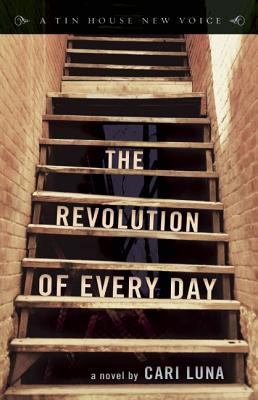
Book Review: The Revolution of Every Day by Cari Luna
Danielle Dorky reviews The Revolution of Every Day, a debut fiction novel from Cari Luna that addresses the revolt against gentrification in New York City in the mid-nineties.
Author: Cari Luna
Book Title: The Revolution of Every Day
Genre: Contemporary Fiction, Literary Fiction
Length: 388 paperback
Publish date: 2013
Publisher: Tin House Books
Previous books: The Everything Spanish Phrase Book
Similar books/authors: Tumbledown by Robert Boswell, Slaves of New York by Tama Janowitz
Re-readability: 7.5 out of 10
Dorkproval rating: [Rating:9/10]
Favorite Quote: “These Americans, the way they argue; the way they won’t back down from a fight no matter how wrong they are; the way they then shrug off the fight and move on to the next thing so easily; their distractibility, like children; their pride–their ridiculous, beautiful pride. He can’t say he understands them, even now, but he knows he’ll never go back to Europe. He knows he’ll die in New York.”
The Revolution of Every Day is the debut novel from native New Yorker Cari Luna. It recounts the recent, but forgotten history of New York City’s Lower East Side and the threats that squatters faced in the mid-nineties when gentrification was bearing down and Mayor Giuliani seemed on a warpath to sweep the city of its grit and character, oblivious to who he was discarding in the process. In descriptive, striking prose, Cari Luna details the lives of a colony of homesteaders who, as their homes and security are being threatened, begin to consider their positions in life and what the future holds beyond their crumbling walls.
As if Luna’s gritty settings needed further elevation, my paperback copy had the uneven, thick parchment papers of a self-bound book one might find in the rubble of a recently bulldozed building. Inexplicably, Chapter 8 was torn from my copy, only a few stumps of paper in the spine left as evidence. Despite my copy being new, there was nothing in the text that alluded to this being purposeful, so I have to assume it was a human error. I also tried a Google search to no avail. Update: Cari Luna reached out to me after reading this review and confirmed that Chapter 8 is not supposed to be missing from the novel. She’s sending me another copy so I can see what I missed!
That small pittance aside, Luna is a master at creating dynamic, flawed characters and instead of feeling knee-jerk pity or resentment, readers are drawn into each squatter’s individual story. It is no small feat that Luna is able to humanize a demographic we’ve conditioned ourselves to ignore.
Amelia is the youngest in Thirteen house and joined the squat at only 16-years-old, taken in by sensitive and damaged Gerrit. It has been seven years since he saved her from the streets, helped her kick heroin, and gave her a place to call home. Now she feels obligated to him in ways that she resents. When she finds out she is pregnant with a married friend and fellow squatter’s child, Amelia must decide who she is willing to rely on.
Gerrit is a refugee from Amsterdam who is at once disdainful and in awe of his American comrades. He loves Amelia, but is losing faith that he can save her as she withdraws more and more throughout her pregnancy. Having witnessed a similar housing revolution in Amsterdam in the eighties, he is skeptical that a peaceful compromise can be reached.
Cat is a former scene queen of Manhattan who’s wondering a) how she’s made it to middle age alive, and b) what the hell she has to show for her wild, infamous youth. She’s the unlikely leader of the Cat House squat, and as she trudges through day-to-day life, she finds herself questioning her sobriety and staving off the rising temptation of heroin.
Steve, a middle-aged Puerto Rican who grew up in the neighborhood he now squats in, is the unofficial leader of Thirteen House. He is married to Anne, and if only he could quiet those inner-demons, he might be able to remain faithful to her. For him, the squats aren’t just a home, they’re an example of what can be achieved when people decide to live for themselves instead of falling into the corporate cog.
Anne is growing weary of her husband Steve’s optimism, especially as what little comfort she has is under threat. At first attracted to his grandiosity and ideas, now Anne wonders if she should have taken a more practical path. She came to the city as naive and principled as any of them, but the monotony that’s taken over their lives makes it difficult to appreciate the revolution they tell themselves they’re participating in.
It was Anne who made me consider the novel’s title beyond its more obvious, heroic translation. Sure, joining a revolution and committing to radical change takes courage, but like any other 9-5, it wears on you, perhaps even more so because you don’t have any medical benefits, vacation package or Christmas bonus to show for it. All you have are the occasional milestones that let you know you’re moving in the right direction, milestones that are infrequent and unpromised, that you’re often unaware of until you look back in hindsight.
The Revolution of Every Day, which is sure to make its way onto required reading lists in the years to come, will change the lens with which you view the world. It will move you to pause before brusquely dismissing the foggy-eyed vagrant on the interstate off-ramp, instead giving him the benefit of the doubt, along with a couple of quarters.
Categories: Uncategorized

